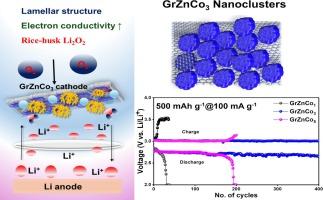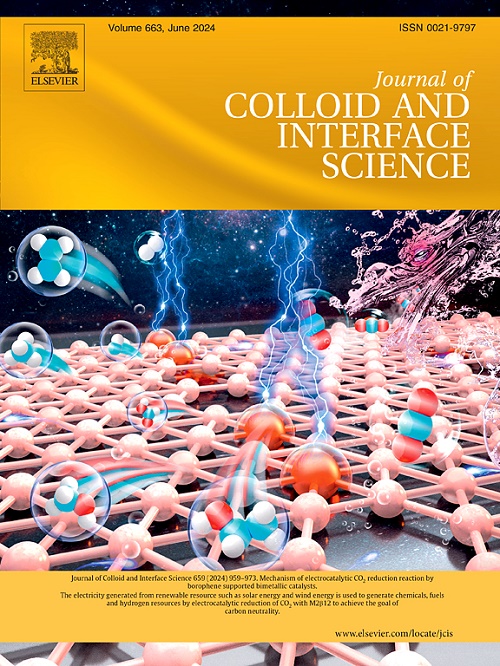Cobalt nanoclusters Deposit on Nitrogen-Doped graphene Sheets as bifunctional electrocatalysts for high performance lithium – Oxygen batteries
IF 9.4
1区 化学
Q1 CHEMISTRY, PHYSICAL
引用次数: 0
Abstract
Rechargeable lithium-oxygen (Li-O2) batteries are being considered as the next-generation energy storage systems due to their higher theoretical energy density. However, the practical application of Li-O2 batteries is hindered by slow kinetics and the formation of side products during the oxygen reduction and evolution reactions on the cathode. These reactions lead to high overpotentials during charging and discharging. To address these challenges, we propose a simple ultrasonic method for synthesizing cobalt nanoclusters embedded in nitrogen-doped graphene nanosheets (GrZnCo) derived from metal-organic frameworks (MOFs). The resulting material, due to the retention of metallic cobalt structure, exhibits better electronic conductivity. Additionally, the GrZnCo catalyst shows vigorous catalytic activity, which can improve reaction kinetics and suppress side reactions, thus lowering the charging overpotential. We have investigated the impact of different catalyst compositions (GrZnCox; x = 1, 3, 5) by varying the amounts of cobalt and zinc. The optimum catalyst, GrZnCo3, contains high cobalt-N active components, graphitic-N, pyridinic-N, pyrrolic-N, and abundant defect structures, which enhance the electrochemical performance. The defect-rich GrZnCo3 catalyst enables Li-O2 batteries to achieve a high discharge capacity of 13500 mAh·g−1 at 50 mA·g−1 and a remarkable long-term cycling performance of over 400 cycles at 100 mA·g−1 with a limited capacity of 500 mAh·g−1. This work demonstrates an effective approach to fabricate cost-effective electrocatalysts for various energy storage systems.

沉积在掺氮石墨烯片上的钴纳米团簇作为高性能锂-氧电池的双功能电催化剂。
可充电锂-氧(Li-O2)电池因其理论能量密度较高而被视为下一代能量存储系统。然而,锂-氧电池的实际应用却受到阴极氧还原和进化反应中缓慢的动力学和副产品形成的阻碍。这些反应导致充电和放电过程中出现高过电位。为了应对这些挑战,我们提出了一种简单的超声波方法,用于合成嵌入氮掺杂石墨烯纳米片(GrZnCo)中的钴纳米团簇,该纳米片源自金属有机框架(MOFs)。由于保留了金属钴结构,由此产生的材料具有更好的电子导电性。此外,GrZnCo 催化剂还具有很强的催化活性,可改善反应动力学并抑制副反应,从而降低充电过电位。我们通过改变钴和锌的含量,研究了不同催化剂成分(GrZnCox;x = 1、3、5)的影响。最佳催化剂 GrZnCo3 含有高钴-N 活性成分、石墨化-N、吡啶-N、吡咯-N 和丰富的缺陷结构,从而提高了电化学性能。富含缺陷的 GrZnCo3 催化剂可使锂-O2 电池在 50 mA-g-1 的条件下实现 13500 mAh-g-1 的高放电容量,并在 100 mA-g-1 的条件下实现超过 400 次的长期循环,有限容量为 500 mAh-g-1。这项工作展示了一种为各种储能系统制造具有成本效益的电催化剂的有效方法。
本文章由计算机程序翻译,如有差异,请以英文原文为准。
求助全文
约1分钟内获得全文
求助全文
来源期刊
CiteScore
16.10
自引率
7.10%
发文量
2568
审稿时长
2 months
期刊介绍:
The Journal of Colloid and Interface Science publishes original research findings on the fundamental principles of colloid and interface science, as well as innovative applications in various fields. The criteria for publication include impact, quality, novelty, and originality.
Emphasis:
The journal emphasizes fundamental scientific innovation within the following categories:
A.Colloidal Materials and Nanomaterials
B.Soft Colloidal and Self-Assembly Systems
C.Adsorption, Catalysis, and Electrochemistry
D.Interfacial Processes, Capillarity, and Wetting
E.Biomaterials and Nanomedicine
F.Energy Conversion and Storage, and Environmental Technologies

 求助内容:
求助内容: 应助结果提醒方式:
应助结果提醒方式:


